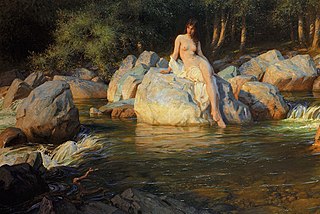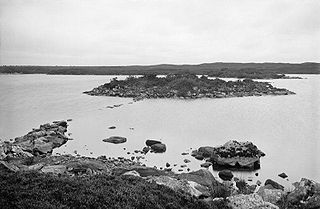Related Research Articles

The Highlands is a historic region of Scotland. Culturally, the Highlands and the Lowlands diverged from the later Middle Ages into the modern period, when Lowland Scots replaced Scottish Gaelic throughout most of the Lowlands. The term is also used for the area north and west of the Highland Boundary Fault, although the exact boundaries are not clearly defined, particularly to the east. The Great Glen divides the Grampian Mountains to the southeast from the Northwest Highlands. The Scottish Gaelic name of A' Ghàidhealtachd literally means "the place of the Gaels" and traditionally, from a Gaelic-speaking point of view, includes both the Western Isles and the Highlands.

A kelpie, or water kelpie, is a shape-shifting spirit inhabiting lakes in Scottish folklore. It is a Celtic legend; however, analogues exist in other cultures. It is usually described as a black horse-like creature, able to adopt human form. Some accounts state that the kelpie retains its hooves when appearing as a human, leading to its association with the Christian idea of Satan as alluded to by Robert Burns in his 1786 poem "Address to the Devil".

The boobrie is a mythological shapeshifting entity inhabiting the lochs of the west coast of Scotland. It commonly adopts the appearance of a gigantic water bird resembling a cormorant or great northern diver, but it can also materialise in the form of various other mythological creatures such as a water bull.

A fuath is a class of malevolent spirits in Scottish Highland folklore, especially water spirits.

The church grim is a guardian spirit in English and Scandinavian folklore that oversees the welfare of a particular Christian church and protects the churchyard from those who would profane and commit sacrilege against it. It often appears as a black dog but is known to take the form of other animals.

The each-uisge is a water spirit in Scottish folklore, known as the each-uisce in Ireland and cabyll-ushtey on the Isle of Man. It usually takes the form of a horse, and is similar to the kelpie but far more vicious.
The bean-nighe is a female spirit in Scottish folklore, regarded as an omen of death and a messenger from the Otherworld. She is a type of ban-sìth that haunts desolate streams and washes the clothing of those about to die. Les Lavandières is the French word under which these "night washerwomen" are perhaps best known. She is also called nigheag, “the little washer,” nigheag na h-ath, “little washer of the ford,” or nigheag bheag a bhroin, “little washer of the sorrow.”
The cù-sìth(e), plural coin-shìth(e) is a mythological hound found in the folklore of Scotland. A similar creature exists in Irish folklore, and it also bears some resemblance to the Welsh Cŵn Annwn.
The wulver is a kind of wolf-like humanoid creature in the folklore of the Shetland Islands of Scotland

An adder stone is a type of stone, usually glassy, with a naturally occurring hole through it. Such stones, which usually consist of flint, have been discovered by archaeologists in both Britain and Egypt. Commonly, they are found in Northern Germany at the coasts of the North and Baltic Seas.

The Inner and Outer Hebrides off the western coast of Scotland are made up of a great number of large and small islands. These isolated islands are the source of a number of Hebridean myths and legends. It is a part of Scotland which has always relied on the surrounding sea to sustain the small communities which have occupied parts of the islands for centuries, therefore, it is natural that these seas are a source for many of these legends.

Achadh nan Darach is a hamlet in Highland, Scotland. It lies near the banks of Loch Linnhe on the A828 road, just south of Kentallen, several miles southwest of Fort William. Its name means "field of oaks". It lies at the edge of the Glen Duror Forest, which stretches further to the east and southeast.
In Scottish folklore the Ghillie Dhu or Gille Dubh was a solitary male fairy. He was kindly and reticent yet sometimes wild in character but had a gentle devotion to children. Dark-haired and clothed in leaves and moss, he lived in a birch wood within the Gairloch and Loch a Druing area of the north-west highlands of Scotland. Ghillie Dhu is the eponym for the ghillie suit.

Dùn Anlaimh, also known as Dùn Amhlaidh, and Eilean nan Cinneachan, is a crannog, located within Loch nan Cinneachan on the Inner Hebridean island of Coll. Upon the crannog there are the remains of walls and several buildings. These remains are not unlike those of other fortified islands found throughout the Outer Hebrides, and it is likely that Dùn Anlaimh dates from the late Middle Ages. According to local tradition on Coll, the fort was once the home of a Norse chieftain who was defeated in battle somewhere nearby. The early 20th century antiquary Erskine Beveridge considered it as one of the four most interesting fortifications, on Coll. The site of Dùn Anlaimh is located at grid reference NM18845684. The RCAHMS classifies the site as a 'crannog' and an 'island dwelling'.

Walter Frederick Campbell of Shawfield (1798–1855), was a Scottish politician. He served as the MP for Argyllshire, 1822–1832 and 1835–1841.
The water bull, also known as tarbh uisge in Scottish Gaelic, is a mythological Scottish creature similar to the Manx tarroo ushtey. Generally regarded as a nocturnal resident of moorland lochs, it is usually more amiable than its equine counterpart the water horse, but has similar amphibious and shapeshifting abilities.

John Gregorson Campbell was a Scottish folklorist and Free Church minister at the Tiree and Coll parishes in Argyll, Scotland. An avid collector of traditional stories, he became Secretary to the Ossianic Society of Glasgow University in the mid-1850s. Ill health had prevented him taking up employment as a Minister when he was initially approved to preach by the Presbytery of Glasgow in 1858 and later after he was appointed to Tiree by the Duke of Argyll in 1861, parishioners objected to his manner of preaching.

The blue men of the Minch, also known as storm kelpies, are mythological creatures inhabiting the stretch of water between the northern Outer Hebrides and mainland Scotland, looking for sailors to drown and stricken boats to sink. They appear to be localised to the Minch and surrounding areas, unknown in other parts of Scotland and without counterparts in the rest of the world.
In Scottish folklore, the beithir is a large snakelike creature or dragon.
In Scottish folklore the Biasd Bheulach is a monster or spirit that haunts Odal Pass on the Isle of Skye in Scotland. It is also known as the Biasd Bealach Odail.
References
Citations
- ↑ Gregorson Campbell (1900), p. 220
- 1 2 Gregorson Campbell (2005), p. 375
- ↑ Martin Devine & Logue (2002), p. 23
Bibliography
- Martin Devine, Thomas; Logue, Paddy (2002), Being Scottish: Personal Reflections on Scottish Identity Today, Edinburgh University Press, ISBN 978-1-902930-36-7
- Gregorson Campbell, John (1900), Superstitions of the Highlands and Islands of Scotland, James MacLehose
- Gregorson Campbell, John (2005) [1990 & 1902], Black, Ronald (ed.), The Gaelic Otherworld: Superstitions of the Highlands and the Islands and Witchcraft and Second Sight in the Highlands and Islands of Scotland, Birlinn, ISBN 978 1 84158 207 8 [ dead link ]